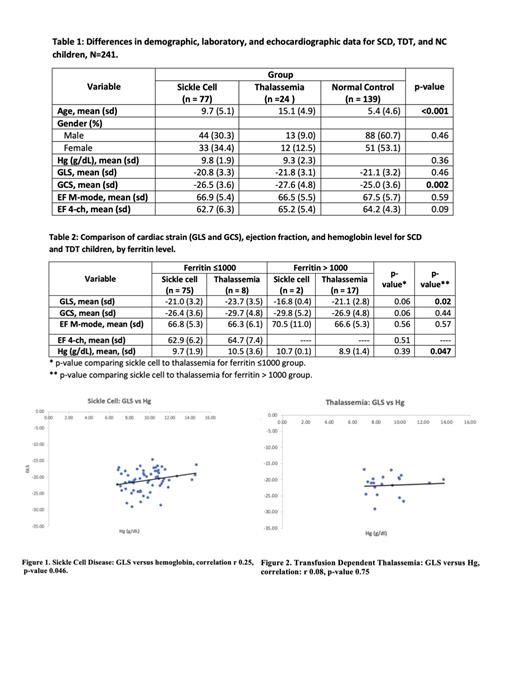Abstract
Cardiac failure is one of the leading causes of death in sickle cell disease (SCD) and transfusion-dependent thalassemia (TDT). For this reason, early detection of silent cardiac dysfunction is crucial for treatment and prevention of heart failure. Speckle-tracking echocardiography (STE) is an easily accessible tool for analyzing myocardial function and this modality has increased sensitivity in detecting asymptomatic disease. Attenuation in cardiac strain has been correlated to early systolic dysfunction among patients with cardiomyopathies. This technique has not been consistently evaluated in children with SCD and TDT. Due to the role of anemia and siderosis in the pathology of cardiac dysfunction, we hypothesized that early myocardial dysfunction correlates with the degree of anemia and hyperferritinemia in SCD. We analyzed the clinical, echocardiographic, STE and laboratory parameters in SCD and compared them to children with TDT and normal controls.
We retrospectively analyzed date from consecutive patients with SCD and TDT who received treatment at our institution from 2008 to 2018. Echocardiographic data from children with benign murmurs served as normal controls (NC). Data was independently verified by a pediatric cardiologist. Descriptive and correlation analysis were used; a p-value < 0.05 was considered significant.
Echocardiographic data were available for 77 SCD (HbSS and HbS/ ß 0 Thal), 25 TDT (ß 0/ ß 0 and ß +/ ß + Thal)and 138 NC. Mean hemoglobin (Hg) and ferritin values were 9.8 g/dl (6.8-14.6 g/dl); 392 ng/ml (19.3-8,3437.67 ng/ml), respectively for SCD patients and 9.3 g/dl (7-17.03 ng/dl); 2,960 ng/ml (13-13,831 ng/ml), respectively for TDT. Standard echocardiographic parameters left ventricular ejection fraction (LVEF), right VEF and LV shortening fraction (LVSF) were within the normal limits in SCD, TDT, and NC children. Significant differences were observed in the steady-state global circumferential strain (GCS) between the three groups SCD, TDT and NC [-26.5 (mean), 3.6 (SD); -27.6 (mean), 4.8(SD); -25.0 (mean), 3.6 (SD), respectively; p = 0.002] (Table 1). Subset analysis based on ferritin levels (> or < 1000 ng/ml), revealed no significant difference in GCS between the SCD or TDT groups (Table 2). However, global longitudinal strain (GLS) was significantly lower among SCD compared to TDT with ferritin levels greater than 1,000 ng/ml (Table 2). A positive correlation (r = 0.25, p = 0.046) was found between GLS and Hg in SCD patients (n=63) (Figure 1). No significant correlation was found between Hg and GLS in the TDT group (Figure 2). No significant correlation was found between GCS and Hg (r = 0.1, p = 0.42); GLS and GCS and ferritin in the SCD group. LVEF was found to be normal in patients with abnormal strain indices.
Cardiac strain indices are abnormal in children with SCD and TDT compared to normal children. Significantly abnormal GLS was noted in hyperferritinemic SCD patients compared to TDT patients. A positive correlation between severity of anemia and GLS was observed in this study in SCD children. Based on these results, we speculate that therapies aimed at ameliorating anemia can potentially improve GLS and thus, early cardiac dysfunction in SCD patients. However, further studies are warranted to understand the contributory role of anemia and hyperferritinemia and its therapeutic implications on early myocardial dysfunction in SCD.
Sathi: Vertex Pharmaceuticals: Consultancy.


This feature is available to Subscribers Only
Sign In or Create an Account Close Modal